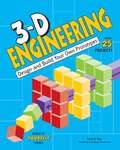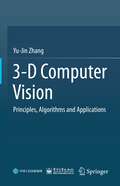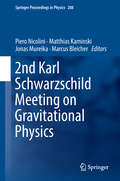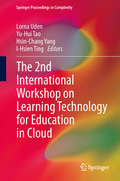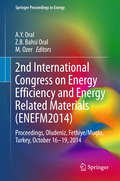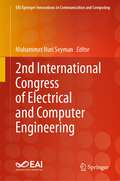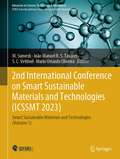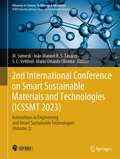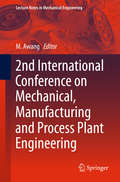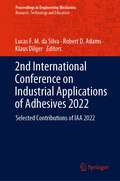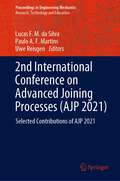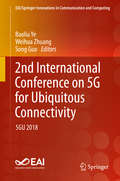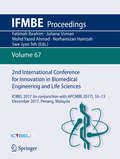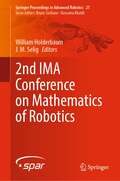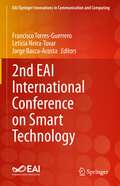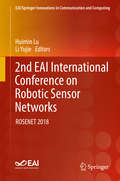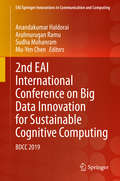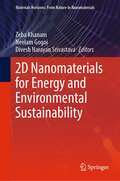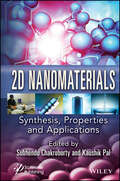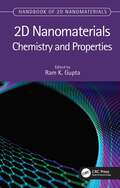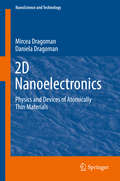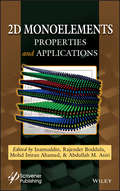- Table View
- List View
3-D Seismic Interpretation
by M. Bacon R. Simm T. RedshawThis book introduces geophysicists and geologists to the technique of interpreting 3-D seismic data. The topics it covers include basic structural interpretation and map-making; the use of 3-D visualization methods; interpretation of seismic amplitudes; the generation and use of AVO and acoustic impedance datasets; and time-lapse seismic mapping. Written by professional geophysicists with many years of working experience in the oil industry, the book will be indispensable for graduate students, researchers, and new entrants into the petroleum industry.
The 3-D Global Spatial Data Model: Principles and Applications, Second Edition
by Earl F. BurkholderTraditional methods for handling spatial data are encumbered by the assumption of separate origins for horizontal and vertical measurements, but modern measurement systems operate in a 3-D spatial environment. The 3-D Global Spatial Data Model: Principles and Applications, Second Edition maintains a new model for handling digital spatial data, the global spatial data model or GSDM. The GSDM preserves the integrity of three-dimensional spatial data while also providing additional benefits such as simpler equations, worldwide standardization, and the ability to track spatial data accuracy with greater specificity and convenience. This second edition expands to new topics that satisfy a growing need in the GIS, professional surveyor, machine control, and Big Data communities while continuing to embrace the earth center fixed coordinate system as the fundamental point of origin of one, two, and three-dimensional data sets. Ideal for both beginner and advanced levels, this book also provides guidance and insight on how to link to the data collected and stored in legacy systems.
3-D Engineering
by Vicki V. MayHow did somebody come up with the idea for bridges, skyscrapers, helicopters, and nightlights? How did people figure out how to build them? In 3D Engineering: Design and Build Your Own Prototypes, young readers tackle real-life engineering problems by figuring out real-life solutions. Kids apply science and math skills to create prototypes for bridges, instruments, alarms, and more. Prototypes are preliminary models used by engineers--and kids--to evaluate ideas and to better understand how things work. Engineering design starts with an idea. How do we get to the other side of the river? How do we travel long distances in short times? Using a structured engineering design process, kids learn how to brainstorm, build a prototype, test a prototype, evaluate, and re-design. Projects include designing a cardboard chair to understand the stiffness of structural systems and designing and building a set of pan pipes to experiment with pitch and volume. Creating prototypes is a key step in the engineering design process and prototyping early in the design process generally results in better processes and products. 3D Engineering gives kids a chance to figure out many different prototypes, empowering them to discover the mechanics of the world we know.
3-D Computer Vision: Principles, Algorithms and Applications
by Yu-Jin ZhangThis textbook offers advanced content on computer vision (basic content can be found in its prerequisite textbook, “2D Computer Vision: Principles, Algorithms and Applications”), including the basic principles, typical methods and practical techniques. It is intended for graduate courses on related topics, e.g. Computer Vision, 3-D Computer Vision, Graphics, Artificial Intelligence, etc. The book is mainly based on my lecture notes for several undergraduate and graduate classes I have offered over the past several years, while a number of topics stem from my research publications co-authored with my students. This book takes into account the needs of learners with various professional backgrounds, as well as those of self-learners. Furthermore, it can be used as a reference guide for practitioners and professionals in related fields. To aid in comprehension, the book includes a wealth of self-test questions (with hints and answers). On the one hand, these questions help teachers to carry out online teaching and interact with students during lectures; on the other, self-learners can use them to assess whether they have grasped the key content.
3 Commando: Helmand Assault
by Ewen Southby-TailyourWhen the Royal Marines Commandos returned to a chaotic Helmand in the winter of 2008, they realised that to stand any chance of success they would need to pursue an increasingly determined Taliban harder than ever before. This time they were going to hunt them down from the air. With the support of Chinooks, Apaches, Lynx, Sea Kings and Harriers, the Commandos became a deadly mobile unit, able to swoop at a moments notice into the most hostile territory.From huge operations like the gruelling Red Dagger, when 3 Commando Brigade fought in Somme-like mud to successfully clear the area around the capital of Helmand, Lashkar Gar, of encroaching enemy forces, to the daily acts of unsupported, close-quarters 360-degree combat and the breath-taking, rapid helicopter night assaults behind enemy lines - this was kind of battle that brought Commando qualities to the fore. As with the Sunday Times bestselling 3 Commando Brigade, ex-Marine Lieutenant Colonel Ewen Southby-Tailyour brings unparalleled access to the troops, a soldier's understanding of the conflict and a visceral sense of the combat experience. This is the real war in Afghanistan as told to him by a hand-picked band of young fellow marines as they encounter the daily rigours of life on the ground in the world's most intense war zone.
2nd Karl Schwarzschild Meeting on Gravitational Physics (Springer Proceedings in Physics #208)
by Piero Nicolini Matthias Kaminski Jonas Mureika Marcus BleicherThis book presents the proceedings of the 2nd Karl Schwarzschild Meeting on Gravitational Physics, focused on the general theme of black holes, gravity and information.Specialists in the field of black hole physics and rising young researchers present the latest findings on the broad topic of black holes, gravity, and information, highlighting its applications to astrophysics, cosmology, particle physics, and strongly correlated systems.
The 2nd International Workshop on Learning Technology for Education in Cloud
by Lorna Uden I-Hsien Ting Hsin-Chang Yang Yu-Hui TaoProceedings from the 2013 LTEC conference in Kaohsiung, Taiwan. The papers examine diverse aspects of Learning Technology for Education in Cloud environments, including social, technical and infrastructure implications. Also addressed is the question of how cloud computing can be used to design applications to support real time on demand learning using technologies. The workshop proceedings provide opportunities for delegates to discuss the latest research in TEL (Technology Enhanced Learning) and its impacts for learners and institutions, using cloud technologies.
2nd International Congress on Energy Efficiency and Energy Related Materials: Proceedings, Oludeniz, Fethiye/Mugla, Turkey, October 16-19, 2014 (Springer Proceedings in Energy)
by A. Y Oral Z.B Bahsi Oral M. OzerThe proceedings of the 2nd International Congress on Energy Efficiency and Energy Related Materials include 73 peer-reviewed technical papers, submitted by leading academic and research institutions from over 20 countries and representing some of the most cutting-edge research available. The 73 papers are grouped into the following sections: - General Issues - Wind Energy - Solar Energy - Nuclear Energy - Biofuels and Bioenergy - Fossil Energy - Hydropower - Energy Storage, Conservation and Efficiency - Environmental Issues - Carbon Capture and Storage - Bio-Assessment and Toxicology - Air Pollution from Mobile and Stationary Sources - Transport of Air Pollutants - Environmentally Friendly Construction and Development - Energy Management Systems - Materials for Sustainable Energy - Materials for Renewable Energy Storage and Conversion - Fuel Cells - Hydrogen Storage - Photovoltaics and Solar Cells - Hydrogen Production and Fuel Generation from Renewables (Catalysis) - Carbon Dioxide Sequestration and Conversion - Energy-Saving Materials - Thermoelectrics - Saving Energy in Buildings - Modeling and Theoretical Aspects in Energy-Related Materials
2nd International Congress of Electrical and Computer Engineering (EAI/Springer Innovations in Communication and Computing)
by Muhammet Nuri SeymanThis proceedings presents the papers included in the 2nd International Congress of Electrical and Computer Engineering (ICECENG), which took place in Bandirma, Turkey, 22-25 November 2023. The conference aims to bring together researchers, developers, and students in computing, technology trends, artificial intelligence, and security who are interested in studying the application of formal methods to the construction and analysis of models describing technological processes at both micro and macro levels. ICECENG’23 also aims to provide a platform for discussing the issues, challenges, opportunities, and findings of computer engineering research. The conference seeks to provide some answers and explore the processes, actions, challenges, and outcomes of learning and teaching.
2nd International Conference on Smart Sustainable Materials and Technologies: Smart Sustainable Materials and Technologies (Volume 1) (Advances in Science, Technology & Innovation)
by M. Sumesh João Manuel R. S. Tavares S. C. Vettivel Mario Orlando OliveiraSustainable materials science and engineering is one of the important characteristics of the existing high-tech revolution. The advances of materials science pave way for technical advancements in materials science and industrial technologies throughout the world. Materials are regarded as critical component in all emerging industries. Exquisite preparation and manufacturing must be carried out before a new material may be used. Nevertheless, electronic materials are undeniably important in many aspects of life. Smart materials and structures is a multi-disciplinary platform dedicated to technical advances in smart materials, systems and structures, including intelligent materials, sensing and actuation, adaptive structures, and active control. Recently, sustainable materials and technologies reshape the electronics industry to build realistic applications. At present, without the impact of sustainability, the electronics industry faces challenges. Researchers are now more focused on understanding the fundamental science of nano, micro, and macro-scale aspects of materials and technologies for sustainable development with a special attention toward reducing the knowledge gap between materials and system designs. The main aim of this international conference is to address the new trends on smart sustainable materials field for industrial and electronics applications. The main purpose of this conference is to assess the recent development in the applied science involving research activity from micro- to macro-scale aspects of materials and technologies for sustainable applications. In such a context, particular emphasis is given to research papers tailored in order to improve electronic and industrial applications and market extension of sustainable materials.
2nd International Conference on Smart Sustainable Materials and Technologies: Innovations in Engineering and Smart Sustainable Technologies (Volume 2) (Advances in Science, Technology & Innovation)
by M. Sumesh João Manuel R. S. Tavares S. C. Vettivel Mario Orlando OliveiraSustainable materials science and engineering is one of the important characteristics of the existing high-tech revolution. The advances of materials science pave way for technical advancements in materials science and industrial technologies throughout the world. Materials are regarded as critical component in all emerging industries. Exquisite preparation and manufacturing must be carried out before a new material may be used. Nevertheless, electronic materials are undeniably important in many aspects of life. Smart materials and structures is a multi-disciplinary platform dedicated to technical advances in smart materials, systems and structures, including intelligent materials, sensing and actuation, adaptive structures, and active control. Recently, sustainable materials and technologies reshape the electronics industry to build realistic applications. At present, without the impact of sustainability, the electronics industry faces challenges. Researchers are now more focused on understanding the fundamental science of nano, micro, and macro-scale aspects of materials and technologies for sustainable development with a special attention toward reducing the knowledge gap between materials and system designs. The main aim of this international conference is to address the new trends on smart sustainable materials field for industrial and electronics applications. The main purpose of this conference is to assess the recent development in the applied science involving research activity from micro- to macro-scale aspects of materials and technologies for sustainable applications. In such a context, particular emphasis is given to research papers tailored in order to improve electronic and industrial applications and market extension of sustainable materials.
2nd International Conference on Mechanical, Manufacturing and Process Plant Engineering (Lecture Notes in Mechanical Engineering)
by Mokhtar AwangThis volume presents selected papers from the 2nd International Conference on Mechanical, Manufacturing and Process Plant Engineering (ICMMPE 2016) which was held from 23rd to 24th November, 2016 in Kuala Lumpur, Malaysia. The proceedings discuss genuine problems of joining technologies that are heart of manufacturing sectors. It discusses the findings of experimental and numerical works from soldering, arc welding to solid state joining technology that faced by current industry.
2nd International Conference on Industrial Applications of Adhesives 2022: Selected Contributions of IAA 2022 (Proceedings in Engineering Mechanics)
by Lucas F. M. da Silva Robert D. Adams Klaus DilgerThis book provides selected papers presented at the 2nd International Conference on Industrial Applications of Adhesives 2022, held in Carvoeiro, Portugal, 3-4 March 2022.The volume focuses on applications of adhesive bonding in the industry such as automotive, aeronautic, railway, marine, energy, and electronics. A wide range of topics like adhesion assessment between polymers and metals, pressure sensitive adhesives, adhesive bonding process optimization, civil applications, adhesive joints in composite materials and elastic adhesives are covered.The book presents the latest results and innovations in this field, useful for adhesive producers and adhesive users.
2nd International Conference on Advanced Joining Processes: Selected Contributions of AJP 2021 (Proceedings in Engineering Mechanics)
by Lucas F. M. da Silva Paulo A. F. Martins Uwe ReisgenThis book focusses on all advanced methods of joining such as friction stir welding, joining by plastic deformation, laser welding, advanced mechanical joining, adhesive bonding and hybrid joining. The volume presents the state-of-the-art of advanced methods of joining and also serves as a reference for researchers and graduate students working in this field.This book gathers selected contributions of the 2nd International Conference on Advanced Joining Processes 2021, held in Sintra, Portugal, on October 21–22, 2021.
2nd International Conference on 5G for Ubiquitous Connectivity: 5GU 2018 (EAI/Springer Innovations in Communication and Computing)
by Baoliu Ye Weihua Zhuang Song GuoThe book presents the proceedings of the 2nd International Conference on 5G for Ubiquitous Connectivity (5GU 2018), which took place on December 4-5, 2018 in Nanjing, People’s Republic of China. The aim of this conference is to bring together researchers and developers as well as regulators and policy makers to present their latest views on 5G, including new networking, new wireless communications, resource control & management, future access techniques, new emerging applications, and latest findings in key research activities on 5G. The book is applicable to researchers, academics, students, and professionals.Features practical, tested applications in 5G for ubiquitous connectivity;Includes discussion of 5G for ubiquitous connectivity in relation to wireless communications, resource control & management, and future access techniques;Applicable to researchers, academics, students, and professionals.
2nd International Conference for Innovation in Biomedical Engineering and Life Sciences: ICIBEL 2017 (in conjunction with APCMBE 2017),10 - 13 December 2017, Penang, Malaysia (IFMBE Proceedings #67)
by Fatimah Ibrahim Juliana Usman Mohd Yazed Ahmad Norhamizan Hamzah Swe Jyan TehThis volume presents the proceedings of ICIBEL 2017, organized by the Centre for Innovation in Medical Engineering (CIME) under Innovative Technology Research Cluster, University of Malaya. It was held in George Town, Penang, Malaysia, from 10-13 December 2017. The ICIBEL 2017 conference promotes the latest research and developments related to the integration of the Engineering technology in medical fields and life sciences. This includes the latest innovations, research trends and concerns, challenges and adopted solution in the field of medical engineering and life sciences.
2nd IMA Conference on Mathematics of Robotics (Springer Proceedings in Advanced Robotics #21)
by William Holderbaum J. M. SeligThis book highlights the mathematical depth and sophistication of techniques used in different areas of robotics. Each chapter is a peer-reviewed version of a paper presented during the 2021 IMA Conference on the Mathematics of Robotics, held online September 8–10, 2021. The conference gave a platform to researchers with fundamental contributions and for academic and to share new ideas. The book illustrates some of the current interest in advanced mathematics and robotics such as algebraic geometry, tropical geometry, monodromy and homotopy continuation methods applied to areas such as kinematics, path planning, swam robotics, dynamics and control. It is hoped that the conference and this publications will stimulate further related mathematical research in robotics.
2nd EAI International Conference on Smart Technology (EAI/Springer Innovations in Communication and Computing)
by Francisco Torres-Guerrero Leticia Neira-Tovar Jorge Bacca-AcostaThis book presents the proceedings of 2nd EAI International Conference on Smart Technology (MTYMEX), which took place April 27th, 2021, online and in Monterrey, Mexico. MTYMEX is an international conference aimed at demonstrating the potential of new applications for the Internet in the future. The authors offer perspectives on research on smart technologies in society, including the results of research projects on virtual reality, blockchain, artificial intelligence, and smart cities. The book offers examples of applications with smart technologies in different knowledge areas. The conference brings together the academic, research and private sectors working on applications and smart devices for e-health and smart cities.
2nd EAI International Conference on Robotic Sensor Networks: ROSENET 2018 (EAI/Springer Innovations in Communication and Computing)
by Huimin Lu Li YujieThis book provides scientific research into Cognitive Internet of Things for Smart Society, with papers presented at the 2nd EAI International Conference on Robotic Sensor Networks. The conference explores the integration of networks and robotic technologies, which has become a topic of increasing interest for both researchers and developers from academic fields and industries worldwide. The authors posit that big networks will be the main approach to the next generation of robotic research, with the explosive number of networks models and increasing computational power of computers significantly extending the number of potential applications for robotic technologies while also bringing new challenges to the network's community. The 2nd EAI International Conference on Robotic Sensor Networks was held 25-26 August 2018 at the Kitakyushu International Conference Center (MICE), Kitakyushu, Japan.
2nd EAI International Conference on Big Data Innovation for Sustainable Cognitive Computing: BDCC 2019 (EAI/Springer Innovations in Communication and Computing)
by Anandakumar Haldorai Arulmurugan Ramu Sudha Mohanram Mu-Yen ChenThis proceeding features papers discussing big data innovation for sustainable cognitive computing. The papers feature details on cognitive computing and its self-learning systems that use data mining, pattern recognition and natural language processing (NLP) to mirror the way the human brain works. This international conference focuses on cognitive computing technologies, from knowledge representation techniques and natural language processing algorithms to dynamic learning approaches. Topics covered include Data Science for Cognitive Analysis, Real-Time Ubiquitous Data Science, Platform for Privacy Preserving Data Science, and Internet-Based Cognitive Platform. The 2nd EAI International Conference on Big Data Innovation for Sustainable Cognitive Computing (BDCC 2019) took place in Coimbatore, India on December 12-13, 2019.Contains proceedings from 2nd EAI International Conference on Big Data Innovation for Sustainable Cognitive Computing (BDCC 2019), Coimbatore, India, December 12-13, 2019;Features topics ranging from Data Science for Cognitive Analysis to Internet-Based Cognitive Platforms;Includes contributions from researchers, academics, and professionals from around the world.
2D Nanomaterials for Energy and Environmental Sustainability (Materials Horizons: From Nature to Nanomaterials)
by Zeba Khanam Neelam Gogoi Divesh Narayan SrivastavaThis book presents cutting-edge research, recent breakthroughs, and unresolved challenges associated with 2D nanomaterials to combat energy and environmental issues. The book discusses the state-of-the-art design and innovations engaged to novel 2D nanomaterials, viz. Transition metal compounds (TMDs, TMOs, TMHs), MXenes, elemental 2D analogs (silicene, phosphorene, arsenene, etc.), Metal-organic frameworks (MOFs), etc. It presents the latest trends on top-down and bottom-up synthesis approaches and properties followed by the critical status and progress of these 2D nanomaterials in the field of energy and environment. The topics cover wide spectrum of 2D nanomaterials applications including energy storage/conversion, air/water/soil remediation, adsorption, photocatalytic degradation, desalination and membrane filtration, detection and sensing, drug delivery systems, and nano-encapsulated agro-formulations. The subsequent section includes a comprehensive account on the safety risk assessment of 2D nanomaterials towards the ecosystem and human health. This book will be beneficial for beginners, researchers, and professionals from diverse fields interested in 2D nanomaterials for energy and environmental sustainability.
2D Nanomaterials: Synthesis, Properties, and Applications
by Subhendu Chakroborty Kaushik Pal2D NANOMATERIALS The book provides a comprehensive overview of the synthesis, modification, characterization, and application of 2D nanomaterials. In recent years, 2D nanomaterials have emerged as a remarkable cornerstone in the field of advanced materials research, with their unique properties and versatile applications captivating the attention of scientists and engineers worldwide. This book is a testament to the ever-growing interest and importance of 2D nanomaterials in the realm of materials science, nanotechnology, pharmaceuticals, and a myriad of engineering specializations. The book is structured into three sections, each delving into different aspects of 2D nanomaterials. The first section explores the synthesis of these materials, providing an overview of both top-down and bottom-up strategies. Understanding the methods by which these materials can be synthesized is crucial for advancing their potential applications. Additionally, this section details the structural characterization of 2D nanomaterials, shedding light on their intricate compositions and properties. The second section examines the diverse characteristics exhibited by 2D nanomaterials. From their magnetic and mechanical properties to their electrical, plasmonic, and optical behaviors, these materials possess an array of intriguing attributes that make them highly attractive for a wide range of applications. This section of the book provides a comprehensive understanding of these properties, enabling readers to appreciate the unique potential of 2D nanomaterials. The final section focuses on the applications of 2D nanomaterials, highlighting their use in various fields such as energy, water purification, biomedical applications, multimodal tumor therapy, and supercapacitor technology.
2D Nanomaterials: Chemistry and Properties
by Ram K. Gupta2D nanomaterials have emerged as promising candidates for use in energy devices owing to their superior electrochemical properties, surface area, nanodevice integration, multifunctionality, printability, and mechanical flexibility. 2D Nanomaterials: Chemistry and Properties covers basic concepts, chemistries, and properties along with theoretical considerations in designing new 2D nanomaterials, especially for energy applications. This book: Discusses the effect of doping, structural variation, phase, and exfoliation on structural and electrochemical properties of 2D nanomaterials Presents synthesis, characterization, and applications of 2D materials for green energy production and storage Explores new aspects of synthesizing 2D nanomaterials beyond traditionally layered structures Examines challenges in using 2D materials for energy applications This book is aimed at materials scientists, chemists, electrochemists, and engineers working in energy disciplines.
2D Nanoelectronics: Physics and Devices of Atomically Thin Materials (NanoScience and Technology)
by Mircea Dragoman Daniela DragomanThis book is dedicated to the new two-dimensional one-atomic-layer-thick materials such as graphene, metallic chalcogenides, silicene and other 2D materials. The book describes their main physical properties and applications in nanoelctronics, photonics, sensing and computing. A large part of the book deals with graphene and its amazing physical properties. Another important part of the book deals with semiconductor monolayers such as MoS2 with impressive applications in photonics, and electronics. Silicene and germanene are the atom-thick counterparts of silicon and germanium with impressive applications in electronics and photonics which are still unexplored. Consideration of two-dimensional electron gas devices conclude the treatment. The physics of 2DEG is explained in detail and the applications in THz and IR region are discussed. Both authors are working currently on these 2D materials developing theory and applications.
2D Monoelements: Properties and Applications
by Rajender Boddula Inamuddin Mohd Imran Ahamed Abdullah M. Asiri2D Monoelements: Properties and Applications explores the challenges, research progress and future developments of the basic idea of two-dimensional monoelements, classifications, and application in field-effect transistors for sensing and biosensing. The thematic topics include investigations such as: Recent advances in phosphorene The diverse properties of two-dimensional antimonene, of graphene and its derivatives The molecular docking simulation study used to analyze the binding mechanisms of graphene oxide as a cancer drug carrier Metal-organic frameworks (MOFs)-derived carbon (graphene and carbon nanotubes) and MOF-carbon composite materials, with a special emphasis on the use of these nanostructures for energy storage devices (supercapacitors) Two-dimensional monoelements classification like graphene application in field-effect transistors for sensing and biosensing Graphene-based ternary materials as a supercapacitor electrode Rise of silicene and its applications in gas sensing


